Wisconsin is among the Midwestern states, but it’s located way up North, so its climate varies between warm and snowy. It has an abundance of lakes, rivers, woodlands, and even beaches. The most famous are Lake Superior, Lake Michigan, St. Croix River, and the Mississippi River.
The diversity of the natural landscape in Wisconsin made it quite rich with thriving wildlife. There are around 700 animal species and an estimated 440 bird species living on the vast lands of Wisconsin. The black bear, the badger, and the Redfox.
In addition, there’s a stunning group of hummingbirds in Wisconsin that birdwatchers shouldn’t miss. Read on to find out amazing facts about these hummingbirds, when do they make an appearance? and what are the easiest ways to find them?
Top 7 Hummingbirds in Wisconsin
Wisconsin is a welcoming habitat for hundreds of animal and bird species. This is a state where wildlife is varied and mostly thriving. Yet, only a few hummingbirds live there, and most of them are only occasional visitors.
With the rare and accidental sightings of hummingbirds in Wisconsin, it’s important to know more about these birds. Mainly, how to identify them, when they happen to be in the neighborhood, and where are their favorite places.
1. Mexican Violetear

- Scientific name: Colibri thalassinus
- Length: 3.8 to 4.7 in
- Weight: 0.17 to 0.20 oz
- Wingspan: 5 to 6 in
The Mexican Violetear, which was formerly known as the Green Violetear, is as its name implies a cocktail of violet, green, and a little blue. It’s medium-sized and intensely colorful, so it shouldn’t be too hard to spot by daylight. It becomes rather gray by night though, which makes it difficult to identify.
It’s one of the rarest species of hummingbirds in Wisconsin, but exciting if you can spot.
Author Note: Most of the Mexican Violetear’s body is covered by scale-like neon-colored feathers. But it has some dark gray patches on its wings. As for its tail, it’s fan-like, and pretty much a solid blue, with just a thin black band across.
This hummingbird likes to live around forests. It seems to prefer the mountain types, but it wouldn’t ming dwelling in forest edges or even forest clearings.
These birds are mostly found in Central and South America, which explains the ‘Mexico’ part of its name. Still, they wander off to the east and north all the way to Ontario. However, these forays are occasional. Spotting a Mexican Violetear up north or in the Midwest is a lucky event.
2. Green-Breasted Mango

- Scientific name: Anthracothorax prevostii
- Length: 4 to 5 inches
- Weight: 0.2 oz
- Wingspan: 5 to 6 in
The Green-Breasted Mango is native to the tropical parts of Central and South America. It might travel a little northward to Texas when it feels adventurous. Otherwise, it’s pretty rare to find these hummingbirds up north.
Interestingly, they were spotted three times in unlikely States. Once in North Carolina in 2000, once in Georgia in 2007, and a single wanderer flew all the way to Wisconsin in the same year. The little hummingbird was then transferred to a zoo, mostly to protect it from the harsh winter.
Even though another sighting isn’t highly probable, it’s still nice to know what this hummingbird looks like; just in case another one flies by!
Green-Breasted Mangoes are medium-sized, rather slender, with long curved bills. The males are the most colorful with plenty more ornamentation than the females or young ones.
To be more specific, males are mostly bright green with dark patches on their chest and throat. They have bluish-green sides and a burgundy tail. Females have less green and more bronze all over their bodies. As for immature birds, these folks are rather buff and inconspicuous.
3. Ruby-Throated Hummingbird
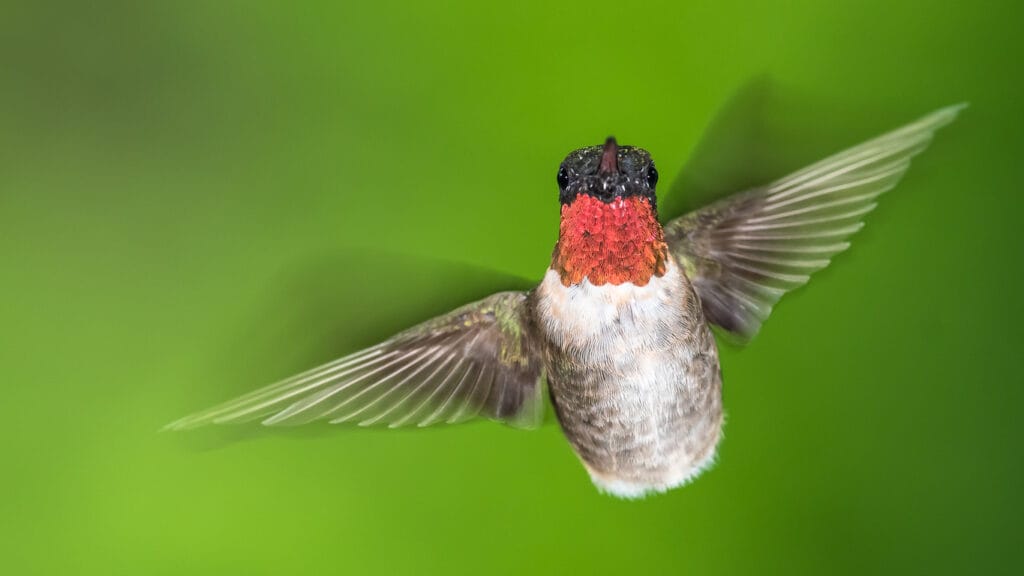
- Scientific name: Archilochus colubris
- Length: 2.8 to 3.5 in
- Weight: 0.1 to 0.2 oz
- Wingspan: 3.1 to 4.3 in
True to its name, the male Ruby-Throated Hummingbird is characterized by vermilion scale-like feathers all around its throat. Females don’t have that flamboyant distinction at all, but they aren’t any less gorgeous.
Author Note: Both males and females are predominantly iridescent aquamarine and totally eye-catching. Their bills are rather straight, and their tails aren’t too spectacular, so their identification would depend primarily on spotting a male Ruby-Throated hummingbird.
This is a hummingbird species that should be easy to find in Wisconsin, as it likes the colder climates of the Northern States all the way to Canada. You can find Ruby-Throated Hummingbirds in open woodlands, citrus groves, orchards, and meadows. It’s one of the most common species of hummingbirds in Wisconsin.
4. Anna’s Hummingbird
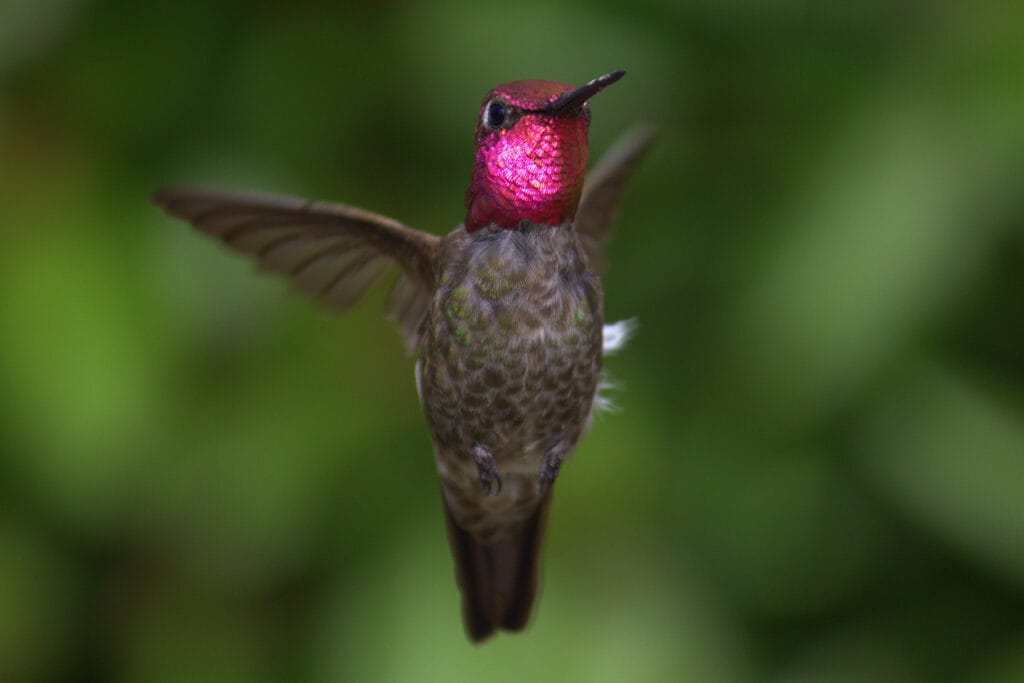
- Scientific name: Calypte anna
- Length: 3.9 in
- Weight: 0.1 to 0.2 oz
- Wingspan: 4.7 in
A male Anna’s Hummingbird is much easier to spot with the fuchsia mantle of feathers all around its neck and throat. Here’s the catch though, you can only see this pinkish patch as the sun reflects on it. Otherwise, it tends to appear brown.
Females and males share a metallic-green back, but the males have bluish highlights that are completely absent from the females. Additionally, the females have buff bellies, leaner bodies, and shorter tails.
Another feature these hummingbirds have is their extra small and rather plump bodies. Their bills are straight and pointy, which is in good proportion with their miniature size.
Anna’s Hummingbirds favor open woodlands, savannahs, and coastal scrub. Still, they wouldn’t mind taking residence in urban or suburban places.
The females often build the nests on high branches. They use spider webs and insect cocoons to weave dead leaves into lovely little homes. It takes around a week to finish this nest, and once they’re done, they start decorating their homes with any colorful or shiny objects they can find.
5. Rufous Hummingbird
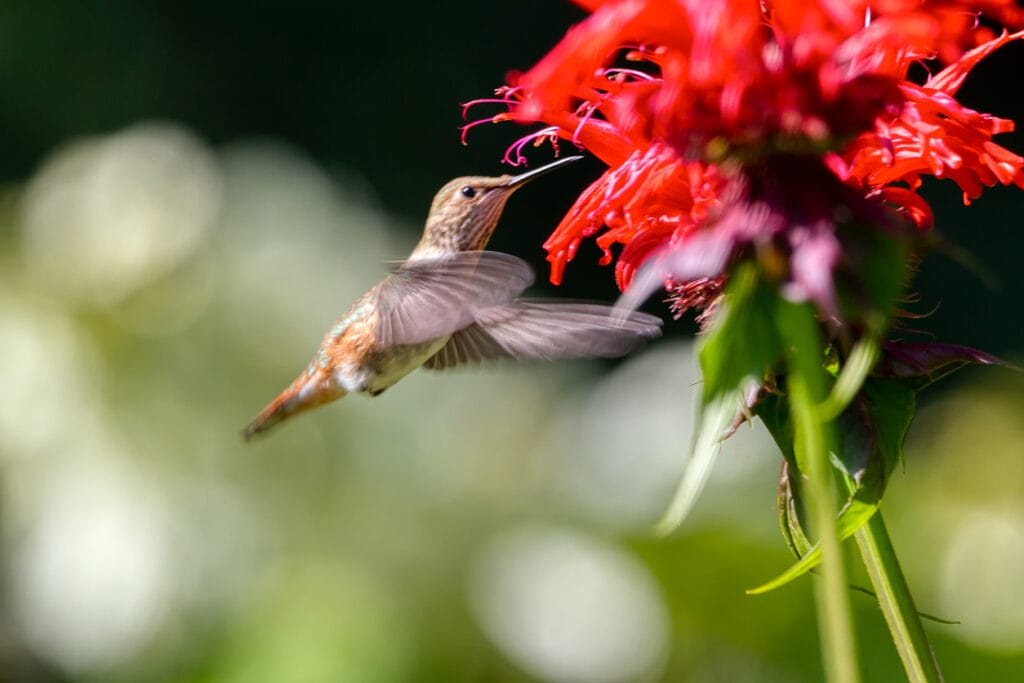
- Scientific name: Selasphorus rufus
- Length: 2.8 to 3.5 in
- Weight: 0.1 to 0.2 oz
- Wingspan: 4.3 in
Rufous Hummingbirds are rather small and stocky with straight longish bills and short pointy tails. The males have beautiful copper-orange feathers that cover most of their backs. They have white bellies and a prominent black streak on their wings.
The females are mostly gray, with a larger white patch on their bellies. They have rust-colored highlights on their flanks and back, but these can only be discerned up close.
These birds appear to be constantly hungry, and maybe that’s why their palate adapted to include insects as well as nectar. They have much more developed air maneuvers that allow them to chase flying bugs, catch them in mid-air, and feast on them. They also steal insects stuck on spider webs.
Rufous Hummingbirds are audacious little birds that protect their territory and boldly ward off other birds. Even when they migrate to new lands, they still exhibit that bravado, and it actually works.
Top Tip: Like many other hummingbirds, these ones too favor open woodlands and mountain meadows. They’re pretty flexible though and were spotted frequently around swamps, thickets, shrubs, and parks.
It’s hard to imagine these tiny creatures taking long travels, but in fact, they’re long-distance migrant birds. They breed and spend their summers in the North around Canada. Then, when summer comes, they fly down south about 4000 miles to enjoy the Mexican warmth.
6. Broad-Billed Hummingbird
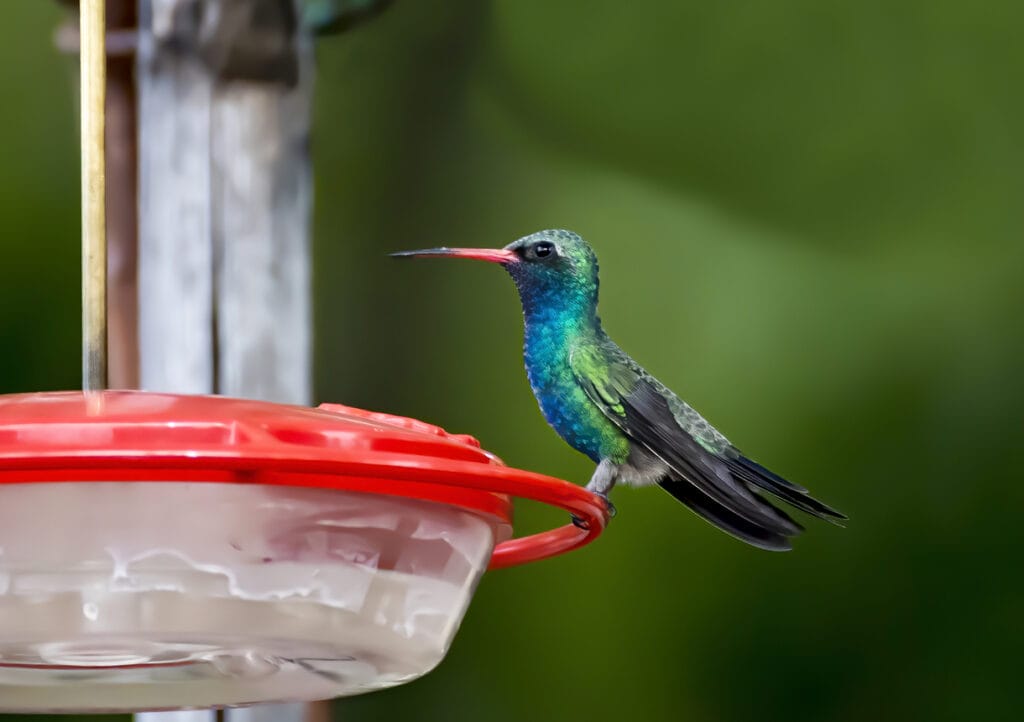
- Scientific name: Cynanthus latirostris
- Length: 3.1 to 3.9 in
- Weight: 0.075 to 0.1 oz
- Wingspan: 5.1 in
The adult male Broad-billed Hummingbird is mostly covered with shimmering neon blue feathers that turn into magenta on the sides and emerald on the belly. Its bill has a unique red tint that ends with a black tip.
Contrary to that burst of color, the females of this species are primarily tan, with little green patches on their backs. Their shorter bills are devoid of color as well, so they might not be that easy to identify.
These birds have a voracious appetite, and they’re known to travel far and away, in search of a wholesome meal. They’ve also been frequently spotted gleaning insects off the trees or flowers. It’s believed that they can mark a certain spot that’s rich in food, and return to it again and again.
Broad-billed Hummingbirds are short-distance migratory birds native to Mexico and the adjacent locations of Central America. They fly a bit to the northwest during the migratory season, and some adventurous individuals reach as far as Wisconsin. It’s a rare matter though.
7. Buff-Bellied Hummingbird
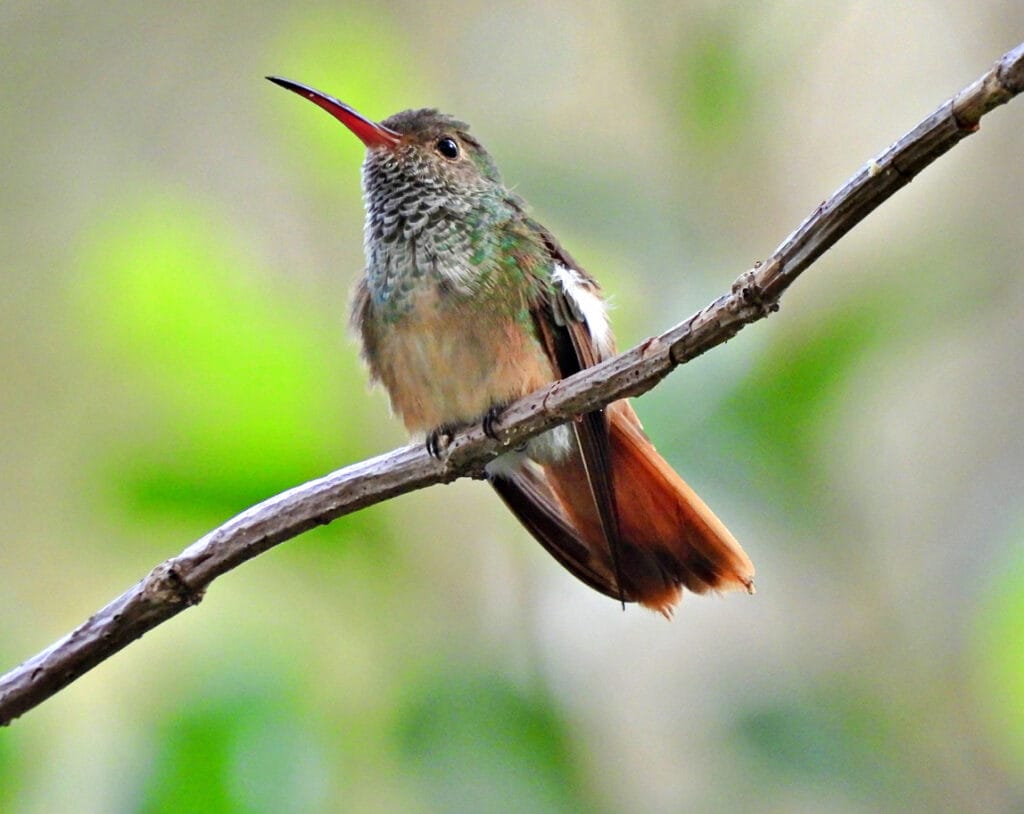
- Scientific name: Amazilia yucatanensis
- Length: 3.9 to 4.3 in
- Weight: 0.14 to 0.18 oz
- Wingspan: 5.75 in
The Buff-bellied Hummingbird has an important feature in common with the Broad-billed one. Interestingly, they both sport unique red bills with black tips. They also have flamboyant colors, but the Buff-bellied folks are more green and bronze than blue.
In addition to the iridescent green feathers, the Buff-bellied Hummingbird has magenta wings and copper fan-shaped tails. Their bellies are, as the name implies, quite buff. The females of this species aren’t too different from the males.
Compared to other hummingbirds, these are a large and plump variety. But if placed beside regular birds, they’d be regarded as really small. They are at best as big as a small sparrow, which makes them tiny little things. Still, they’d be easier to spot that many other hummingbirds.
Author Note: Buff-bellied Hummingbirds love nectar, but they supplement their diet with insects. They often catch their lunch on the fly, but they can also lick the insects off trees, flowers, and dry branches.
Being larger than the other hummingbirds has its merits, and the Buff-belly knows that well. It uses its bigger stature and louder voice to chase away any smaller intruders. This way, it gets to grab all the food in the area!
These birds are most comfortable in the southern lands extending from Guatemala to Texas. They rarely venture up north, and that’s why their sightings in the Midwestern and Northern States are quite rare.
General Characteristics of Hummingbirds
There are about 350 species of hummingbirds, most of them living in South and Central America. A few are casual visitors in North America and the Caribbean, but they normally don’t venture outside the Newworld territories.
Hummingbirds are tiny little birds with lovely colors and slender bodies. They were traditionally called coquettes, sun gems, fairies, and a host of similarly adorable names. That was the way naturalists used to describe them.
They gained their more common description as ‘humming’ birds owing to the distinct sound their wings made as they fluttered around. These birds are known to flap their wings 50-200 times per second, with the smaller ones doing more of the flapping!
This ultra-active lifestyle is a result of their rather different biology. Their wings are hinged to their skeletons in a unique manner that allows quick flapping and an extra-wide range of motion.
Additionally, their hearts beat at a mind-blowing rate of 1200 beats per minute. That’s more than ten times the average for humans, which is about 80 beats per minute.
Normal birds often move forward and upward, but that’s not the case for hummingbirds. They are unique among other birds in their ability to move forward, backward, sideways, upward, downward, and, to simply hover in place.
Interestingly, they don’t do so well on the ground. They become quite awkward as they try to walk or jump about. Clearly, they are designed in a way that helps a lot in their lifestyle of collecting nectar from flowers.
Despite being around flowers all day, hummingbirds aren’t blessed with a particularly enviable sense of smell. They can’t really enjoy all the fragrance surrounding them, but they do have sharp eyesight. At least they take pleasure in the beauty of the gardens.
Conclusion
If you like exploring the beauty of nature, then you’ll find plenty of attractions in Wisconsin. You might be really lucky and get to see all of the seven hummingbirds we listed here. But even if you encounter just a few of them, you can still see hundreds of other animals and birds.
Make sure to visit the woodland areas, Lake Michigan, the Wisconsin deer park, Heckrodt Wetland Reserve, and the Schlitz Audubon Nature Center.
We hope you enjoyed our guide on hummingbirds in Wisconsin.
FAQ
To find out where recent sightings of hummingbirds have been, try eBird. You can search for the latest sightings or particular species or what has been seen in a certain area.
The Ruby-throated Hummingbird is the most common in Wisconsin.
Common species of hummingbird are attracted to backyard bird feeders so put one up and your own home will be a good place to see them!




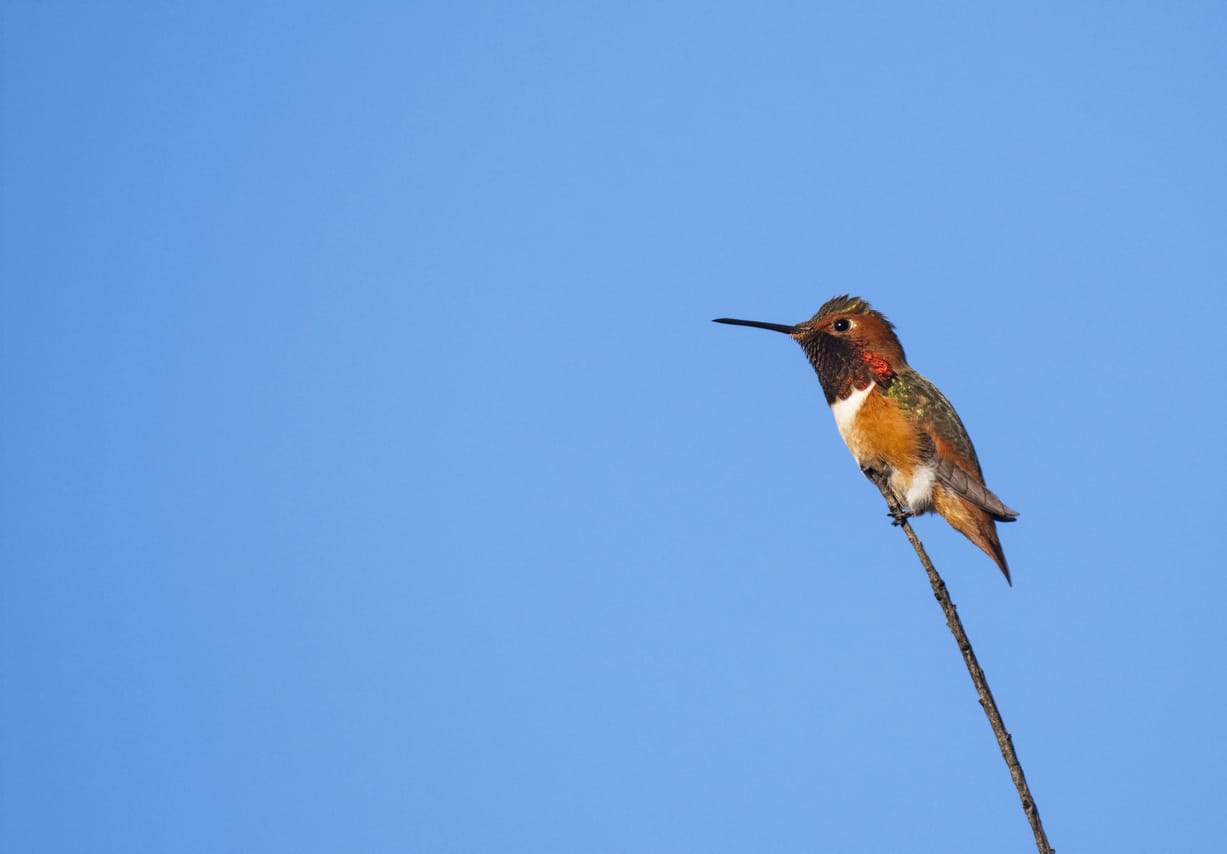
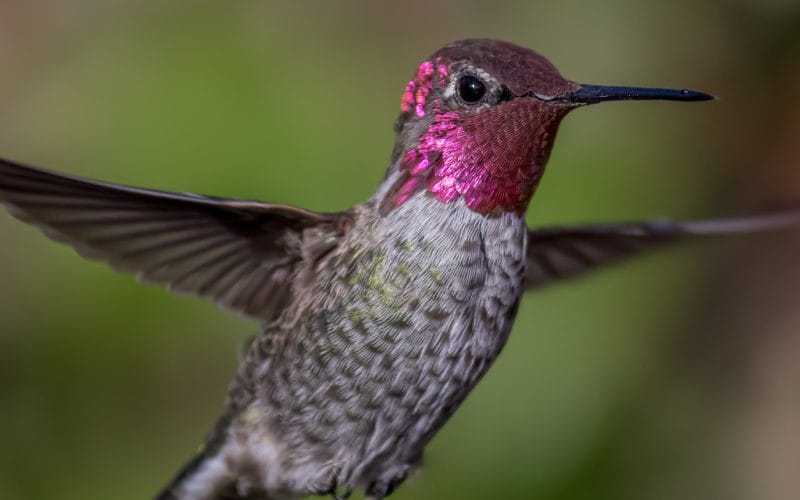
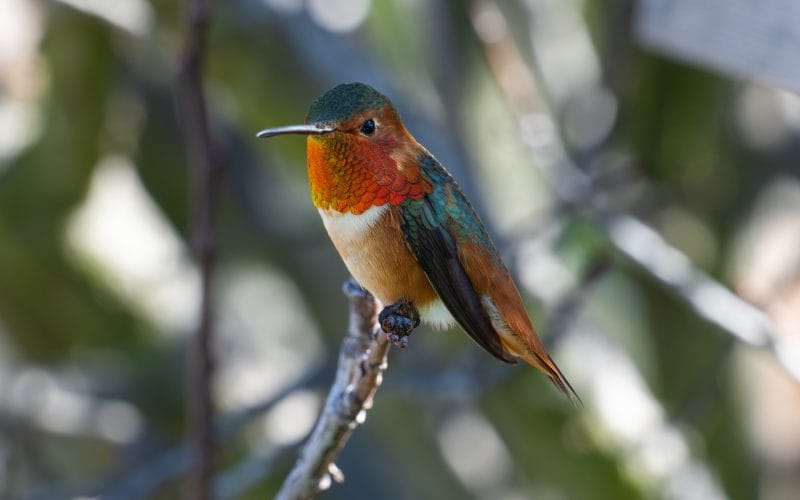

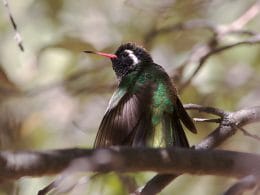

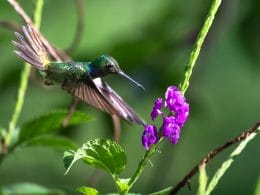
Glad I finally stumbled across your web site. I saw an absolutely stunning emerald green hummingbird two days ago. I only saw it for a few seconds since our small dogs were out side and the bird couldn’t goes to the flowers. Nothing quite fit until I saw your pictures of this bird from the back-top perspective. I was taken by the gorgeous, shimmering emerald green plumage, but also noticed the black bill, a dark narrow “collar” on the side of the neck and non- descript tail (from my perspective). We live in the Madison, Wi area.